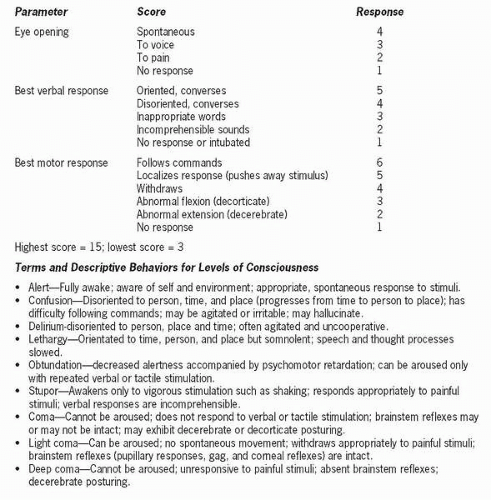Altered Level of Consciousness and Increased Intracranial Pressure
Full consciousness is a state of awareness of oneself and one’s environment and the ability to respond or interact with the environment. Coma is a state of total lack of awareness and wakefulness accompanied by the inability to respond to vigorous stimulation. Between these two extremes, there is a full spectrum of different levels of awareness and responsiveness. Unconsciousness itself is not a diagnosis or disease but is a manifestation of various pathological processes. There are many causes of unconsciousness, including structural and metabolic alterations or diseases.
The rigid cranial cavity holds brain tissue, blood, and cerebrospinal fluid (CSF). The volume of these three components and the intracranial pressure (ICP) they create are normally in equilibrium. Increased ICP is a life-threatening situation that results from an increase in any or all of these components. Increased ICP is a common factor in many pathological conditions affecting the brain due to masses, head injury, infection, vascular insults, toxic and metabolic conditions such as fluid and electrolyte imbalances, and hypoxia. Regardless of cause, increased ICP affects cerebral blood flow, produces compression and distortion of structures, and shifts content. If left untreated, increased ICP causes decompensation of neurological function, leading to death.
Pathophysiology
There are two primary components of consciousness: arousal and content of thought. Arousal refers to a state of wakefulness that is a function of the upper brainstem and, in particular, the reticular activating system (RAS). Content of thought refers to the ability to think, reason, feel, and react to stimuli with purpose. These activities are mediated by the cerebral hemispheres. A functioning brainstem can maintain wakefulness even without a functioning cerebrum, which is a condition referred to as persistent vegetative state. Disruptions in arousal, content, or both can alter the level of consciousness (LOC). Other LOCs include confusion, delirium, stupor, and coma (including irreversible coma and brain death).
The etiology includes any condition that widely disrupts the functioning of both cerebral hemispheres or depresses or destroys the upper brain stem. Supratentorial mass lesions, such as a hematoma, interrupt consciousness by compressing and shifting cerebral contents, causing direct compression of the brainstem RAS or herniation through the falx cerebri or tentorial notch. Infratentorial mass lesions can also disrupt the RAS through compression or herniation. Metabolic problems or diffuse cerebral disorders can disturb cerebral metabolism. Metabolic conditions that disrupt consciousness include uremia, liver failure, diabetes, hypoglycemia, toxins such as alcohol, and drug overdose. Encephalitis and seizures can diffusely affect the cerebral cortex.
Stay updated, free articles. Join our Telegram channel

Full access? Get Clinical Tree



